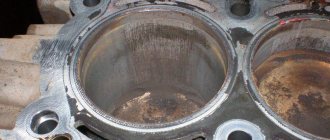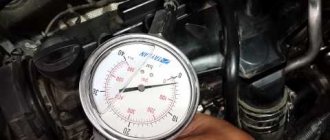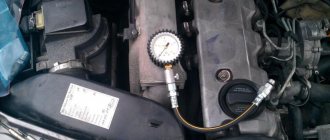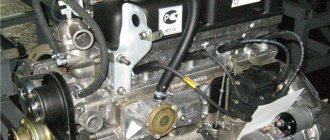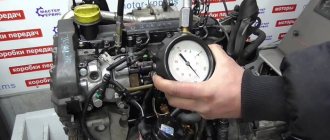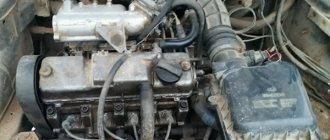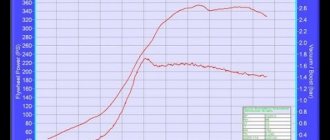The compression indicator of the cylinder-piston group allows you to determine the condition of the internal combustion engine or its individual elements. Most often, this parameter is replaced when the power of the power unit has noticeably decreased or when difficulties are observed with starting the engine.
Let's consider for what reasons the pressure in the cylinders may drop or disappear altogether, how to check this parameter, what tool is needed for this, as well as some of the subtleties of this procedure.
What does a compression test show: main faults
Before considering how to measure compression, it is necessary to understand the definition itself. It is often confused with the compression ratio. In fact, the compression ratio is the ratio of the volume of the entire cylinder to the volume of the compression chamber (the space above the piston when it is at top dead center).
This is a constant value, and it changes when the parameters of the cylinder or piston change (for example, when replacing a piston from a convex to a flat one, the compression ratio decreases as the volume of the compression chamber increases). It is always indicated by a fraction, for example 1:12.
Compression (more accurately defined as pressure at the end of the compression stroke) refers to the maximum pressure that the piston creates when it reaches top dead center at the end of the compression stroke (both intake and exhaust valves are closed).
Compression depends on the compression ratio, but the second parameter does not depend on the first. The pressure value at the end of the compression stroke also depends on additional factors that may be present during measurements:
- pressure at the beginning of the compression stroke;
- how the valve timing is adjusted;
- temperature during measurements;
- leaks in the cylinder;
- crankshaft starting speed;
- dead battery;
- excessive amount of oil in the cylinder (if the cylinder-piston group is worn);
- resistance in the intake manifold pipe;
- motor oil viscosity.
Some mechanics try to increase engine power by increasing the compression ratio. In fact, this procedure only slightly changes this parameter. You can read about other ways to add “horses” to the engine in a separate article.
Changed compression ratio
What does pressure at the end of the compression stroke affect? Here are just a few factors:
- Cold engine start. This factor is especially important for diesel engines. In them, the air-fuel mixture is ignited due to the temperature of highly compressed air. For gasoline units, this parameter is no less important.
- In some cases, a decrease in compression causes an increase in crankcase gas pressure. Because of this, a larger volume of oil vapor enters back into the engine, which leads to increased exhaust toxicity, as well as contamination of the combustion chamber.
- Vehicle dynamics. As compression decreases, engine response drops noticeably, fuel consumption increases, and the oil level in the crankcase drops faster (if lubricant leaks through the oil scraper ring, the oil burns, which is accompanied by blue smoke from the exhaust pipe).
There is no universal value for the pressure at the end of the compression stroke, since it depends on the parameters of the individual power unit. In view of this, it is impossible to name a universal compression value for all power units. This parameter can be found in the technical documentation of the vehicle.
When a change in pressure is detected during measurements, this may indicate the following malfunctions:
- Piston wear. Since these parts are made of aluminum, they will wear out over time. If a hole forms in the piston (burns out), compression in that cylinder can be greatly reduced or practically disappear (depending on the size of the hole).
- Burnout of valves. This often happens when the ignition is set incorrectly. In this case, combustion of the air-fuel mixture occurs when the valve is open, which leads to overheating of its edges. Another reason for the valve seat or “plate” to burn out is a lean air-fuel mixture. A decrease in compression can also be a consequence of the fact that the valves do not sit tightly in the seats (deformed). Gaps between the valve and its seat cause premature leakage of gases, causing the piston to push out with insufficient force.
- Damage to the cylinder head gasket. If for some reason it bursts, gases will partially leak into the resulting crack (the pressure in the cylinder is high, and they will definitely find a “weak spot”).
- Wear of piston rings. If the rings are in good condition, they regulate oil flow and seal the sliding movements of the piston. Another of their functions is to remove heat from the piston to the cylinder walls. When the tightness of the compression pistons is broken, exhaust gases penetrate to a greater extent into the crankcase rather than being removed into the exhaust system. If the oil scraper rings wear out, more lubricant enters the combustion chamber, which leads to increased oil consumption.
Also, during measurements, it is worth paying attention to the extent to which the pressure in the cylinders has changed. If the procedure showed a uniform decline in the indicator in all cylinders, then this indicates natural wear of the cylinder-piston group (or some of its parts, for example, rings).
When the pressure at the end of the compression stroke of one cylinder (or several) differs significantly from the compression in others, this indicates a malfunction in this unit. Among the reasons are the following:
- Burnt out valve;
- Sagging piston rings (mechanics call this “stuck rings”);
- Burnt out cylinder head gasket.
Engine compression: what is it and what is it used for?
Compression, in simple terms, is the pressure generated at the highest point of movement of the crankshaft during the compression stroke. Factors influencing changes in the compression ratio can tell a lot about the condition of the engine, its level of wear and possible problems that affect its normal functioning and the behavior of the car as a whole.
Measuring engine compression using instruments
Such factors include timing defects, wear of the piston group, coking of parts and many others. Deterioration of the technical parameters of the power unit, a sharp jump in fuel consumption - all these are the consequences of changing the compression value up or down, regardless of what specific reasons were the impetus for this.
Pressure is measured in atmospheres. Some pressure gauges use other units of measurement - bar, Megapascal.
Factors affecting internal combustion engine compression
The compression level directly depends on the volume of incoming air flow, which, in turn, depends on the problems and defects listed above. Separately, it is worth mentioning the throttle valve, which has a significant impact on compression in the cylinders: its position is regulated by air flow. Its intensity, in turn, depends on the air filter: drivers often forget to clean and change it when it gets dirty, which leads to a deterioration in its capacity.
A dirty air filter reduces engine compression
Compression values can vary greatly depending on the set gas distribution phases: if errors are made during their installation, the closing moment of the intake valve changes, which moves the cylinder in a certain direction.
The compression ratio can vary depending on the width of the clearances in the valve actuator. For example, the pressure may decrease if the gap is too small, causing the closing of the intake valves to be delayed. At the same time, valve overlap increases - the angle at which the valves open at the same time. This also has a negative impact on compression levels.
Due to the low temperature of the internal combustion engine, the air flow entering a cold engine does not have time to expand and warm up sufficiently, without subsequently creating the required pressure - accordingly, the compression value of the cylinders also drops.
One of the reasons for reduced compression is valve clearances
The presence of valve clearances leads to air leaks. Their intensity is influenced by certain factors that have a similar effect on the amount of compression:
- Motor temperature. As it increases, compression also increases, since the distance between the parts decreases;
- Engine oil supply. A tighter fit of the engine's rubbing parts to each other is ensured by an oil layer on their surface, which also makes it possible to reduce gaps and reduce air leaks through them;
- Fuel supply. The oil film formed on the inner surface of the cylinders when fuel drops enter is quickly washed away, which can stall the operation of the entire internal combustion engine, increases friction and reduces the density of contact of surfaces to each other;
- Depressurization of pressure gauge hoses, check valve, high force applied by springs;
- Increase in crankshaft speed.
What does engine compression affect?
The engine compression level affects various processes and engine parameters:
- Completeness of fuel combustion;
- Engine oil consumption;
- Ease of starting the engine. A decrease in pressure below normal makes it much more difficult to start the engine, especially in the cold season;
- Correct operation of the cylinders. Low compression can increase the risk of engine stalling;
- Power. The lower the compression, the lower the power.
Equipment for self-measurement: compression meter and AGC
Engine compression measurements are carried out to identify indirect engine malfunctions. The following tools are used for accurate diagnosis:
- Compressometer;
- Compressograph;
- Cylinder leakage analyzer.
Compressometer
It allows you to conduct a budget check of the condition of the central heating plant. The cheap model costs around $11. It will be enough for several measurements. The more expensive version costs about $25. Its kit most often includes several adapters with hoses of different lengths.

